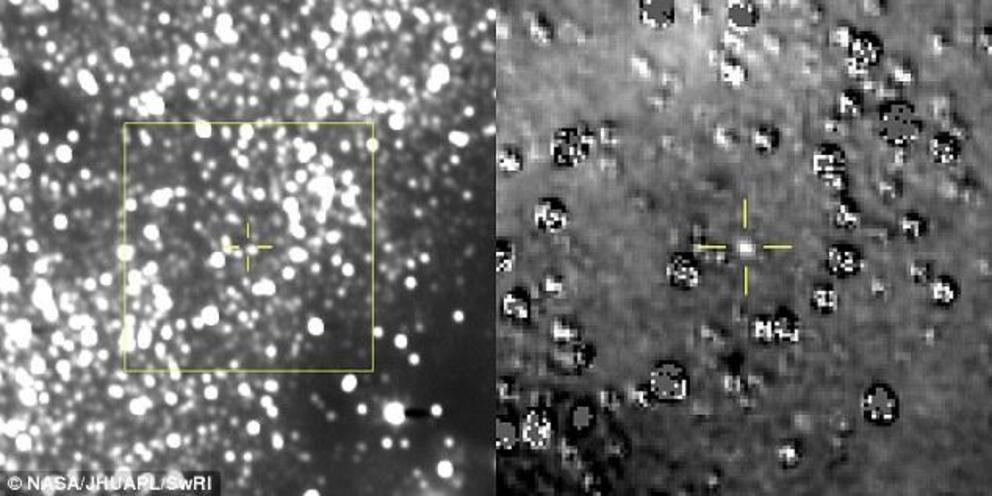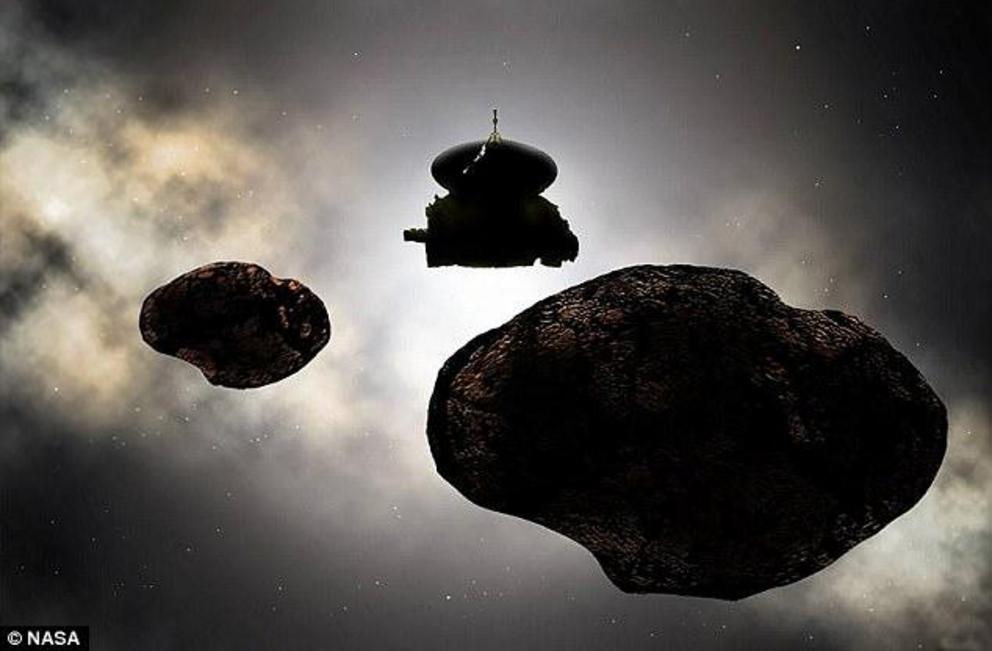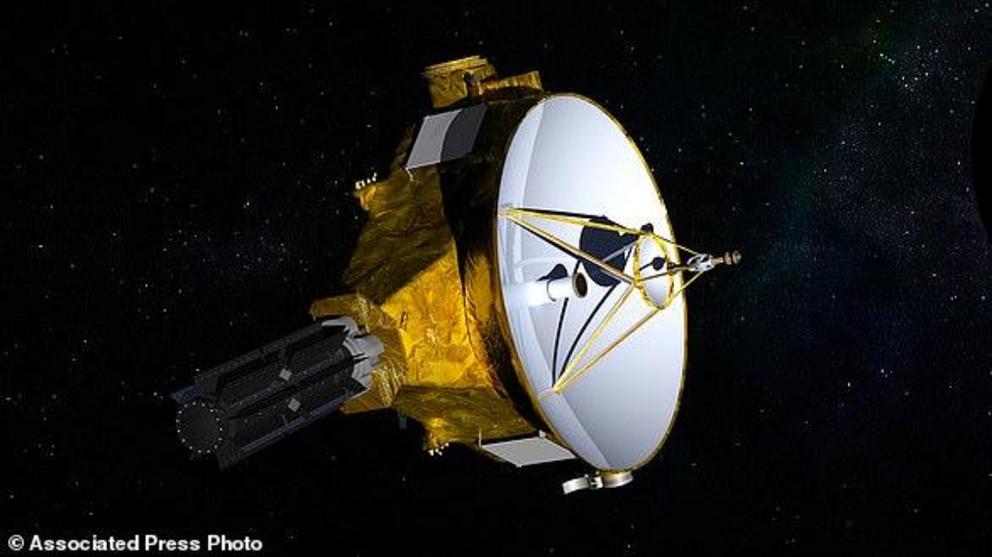New Horizons captures image of its Kuiper Belt target from 100 million miles away as it approaches the most distant object ever explored
- New Horizons is on its way to distant object known as Ultima, for approach Jan 1
- It captured its first image of object using Long Range Reconnaissance Imager
- Though it was over 100 million miles away, images confirmed predicted location
NASA’s New Horizons spacecraft has spotted its next flyby target from more than 100 million miles away.
The veteran craft is on its way to a Kuiper Belt object known as Ultima, which it’s expected to approach on Jan. 1, 2019.
Using its Long Range Reconnaissance Imager (LORRI), however, New Horizons has caught its first glimpse of the faraway object, suggesting it’s on the right path toward its orbit.
 NASA’s New Horizons spacecraft has spotted its next flyby target from more than 100 million miles away. In the image, Ultima is enveloped in countless stars, appearing as just a tiny speck amidst the bright spots. The yellow box shows its predicted locati
NASA’s New Horizons spacecraft has spotted its next flyby target from more than 100 million miles away. In the image, Ultima is enveloped in countless stars, appearing as just a tiny speck amidst the bright spots. The yellow box shows its predicted locati
A composite image of photos captured on August 16 and transmitted through NASA’s Deep Space Network shows the position of Ultima as it corresponds to its predicted location.
This is the team’s first attempt to find it with New Horizons’ cameras.
In the image, Ultima is enveloped in countless stars, appearing as just a tiny speck amidst the bright spots.
‘The image field is extremely rich with background stars, which makes it difficult to detect faint objects,’ said Hal Weaver, New Horizons project scientist and LORRI principal investigator from the Johns Hopkins Applied Physics Lab.
‘It really is like finding a needle in a haystack. In these first images, Ultima appears only as a bump on the side of a background star that’s roughly 17 times brighter – and easier to see – as the spacecraft gets closer.’
Over the next four months, New Horizons will get closer and closer until Ultima, before reaching its minimum distance on January 1.
When it completes the flyby, it will be the first-ever close investigation of a Kupier Belt object and the furthest planetary body ever studied.
New Horizons previously set this record when it studied Pluto.
 It remains unclear if Ultima is a single body, a binary pair, or a system of many objects. The veteran craft is on its way to the Kuiper Belt object, which it’s expected to approach on Jan. 1, 2019. Artist's impression pictured
It remains unclear if Ultima is a single body, a binary pair, or a system of many objects. The veteran craft is on its way to the Kuiper Belt object, which it’s expected to approach on Jan. 1, 2019. Artist's impression pictured
WHAT'S NEXT FOR NASA'S NEW HORIZONS SPACECRAFT?
The spacecraft that gave us the first close-up views of Pluto now has a much smaller object in its sights.
New Horizons is now track to fly past a recently discovered, less than 30-mile-wide object out on the solar system frontier.
The close encounter with what's known as 2014 MU69 would occur in 2019. It orbits nearly 1 billion miles (1.6 billion kilometers) beyond Pluto.
Nasa and the New Horizons team chose 2014 MU69 in August as New Horizons' next potential target, thus the nickname PT-1. Like Pluto, MU69 orbits the sun in the frozen, twilight zone known as the Kuiper Belt.
 This illustration provided by NASA shows the New Horizons spacecraft. The probe whipped past Pluto in 2015 and is headed to 2014 MU69 for an attempted 2019 flyby of the tiny, icy world on the edge of the solar system
This illustration provided by NASA shows the New Horizons spacecraft. The probe whipped past Pluto in 2015 and is headed to 2014 MU69 for an attempted 2019 flyby of the tiny, icy world on the edge of the solar system
MU69 is thought to be 10 times larger and 1,000 times more massive than average comets, including the one being orbited right now by Europe's Rosetta spacecraft.
On the other end, MU69 is barely 1 percent the size of Pluto and perhaps one-ten-thousandth the mass of the dwarf planet. So the new target is a good middle ground, according to scientists.
The spacecraft was recently approved for its extended mission, allowing it to continue on its path toward the object deeper in the Kuiper Belt.
It's expected that New Horizons will make its approach to the ancient object on January 1, 2019.
‘Our team worked hard to determine if Ultima was detected by LORRI at such a great distance, and the result is a clear yes,’ said New Horizons Principal Investigator Alan Stern, of the Southwest Research Institute.
Ultima, initially dubbed Ultima Thule, got its nickname earlier this year after the space agency solicited suggestions from the public.
Its official name is 2014 MU69.
The nickname comes from medieval literature and refers to a distant, unknown world.
After the flyby, however, it will likely receive another, more formal name.
It remains unclear if Ultima is a single body, a binary pair, or a system of many objects.
Video can be accessed at source link below.
